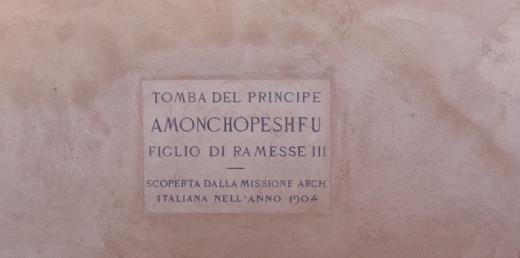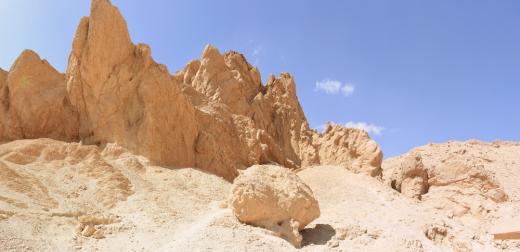QV 50
Unfinished
Entryway A
See entire tombGate B
See entire tombThis gate provides access to the unfinished tomb. A preparatory layer of packing materials is visible on the entryway lintel.
Chamber B
See entire tombThis chamber is irregular in shape and lies perpendicular to the tomb's entryway axis. The eastern section of the chamber is unfinished and there is a break in the eastern wall through to the Ramp of unfinished QV 49. Presumably the later construction of QV 50 was abandoned after this unintentional connection was made. The rock in this chamber is highly fractured and the north wall has substantial salt formations.
About
About
QV 50 is located at the Y-junction of the main and side wadis. It is entered through a short Ramp (A) to a rectangular-shaped chamber (B) perpendicular to the entrance axis. This chamber connects to QV 49 on the east side through a small opening. Presumably the later construction of QV 50 was abandoned after this unintentional connection was made with QV 49. According to Christian Leblanc, the date of construction of QV 50 is the 20th Dynasty.
Site History
Dating
This site was used during the following period(s):
Exploration
Conservation
Site Condition
According to the GCI-SCA, though highly fractured, QV 50 appears in stable condition. The north wall of chamber (B) has substantial salt formations. Small areas of plaster remain on the upper west side wall, as well as a preparatory layer of packing materials found on the upper part of north and east walls of the Ramp and the entryway lintel. The inherent quality of the rock and the presence of salts, particularly as veins within the rock, are the primary cause of rock fracturing and detachment. Exposure to moisture has and will continue to exacerbate these weaknesses in the rock.


Articles
Tomb Numbering Systems in the Valley of the Queens and the Western Wadis
Geography and Geology of the Valley of the Queens and Western Wadis
Bibliography
Demas, Martha and Neville Agnew (eds). Valley of the Queens. Assessment Report. Los Angeles: The Getty Conservation Institute, 2012, 2016. Two vols.
Thomas, Elizabeth. The Royal Necropoleis of Thebes. Princeton: privately printed, 1966.




